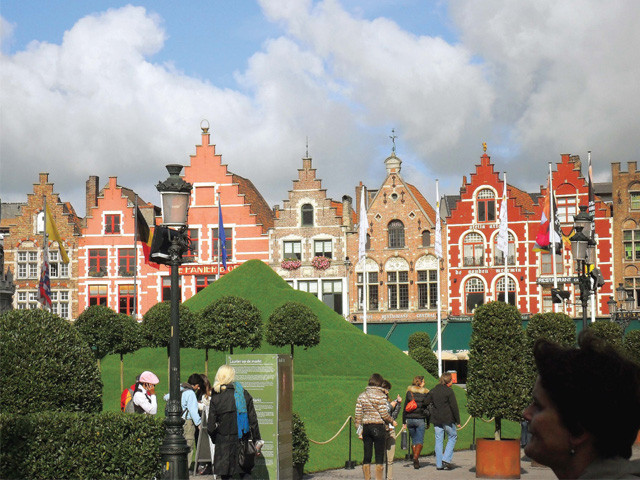Fairytale Bruges
Bruges is a sensual, romantic place — to behold with all your senses and sensibilities rather than to see.

As I walked the streets of this fairytale town, I feared that I would not find the words to describe its character and its beauty. I also expected the Pied Piper of Hamelin to come piping round the next corner preceded by his music and followed by his entourage of mesmerised rodents heading to commit hara-kiri in the North Sea. Or Rapunzel, to let down her hair from a towering spire. Although the Pied Piper and Rapunzel are both German, I can picture them here, among the medieval, Gothic architecture of this city. Brick and stone buildings rise from cobblestone streets, encircle the squares, and gaze narcissistically into canal waters.
I’m torn between luxuriating in the hotel — the historic Oud Huis Amsterdam, once a gubernatorial residence — where I have a canal view. I also have a marble fireplace, an old armoire, and enough floor space to allow me to lay my suitcase flat out and be able to make it to the bathroom. But the desire to discover is strong, as is the lure of a beautiful day…
Bruges, incidentally, is known as the Venice of the north and this means a cruise but our first stop is the Church of Our Lady to pay our respects to Michelangelo’s Madonna and Child. This sublime marble sculpture when viewed to the calming sounds of chanting is a spiritual experience that stirs the soul.
With the spirit edified, it is time to feed the body. I opt for a waffle with sugar and butter and marvel at its flaky-crisp exterior and spongy soft, but perfectly cooked, insides.
A river runs through it
A visit to the Venice of the north is incomplete without a canal cruise which provides a decent interval and necessary reprieve during an entire day of culinary adventurism and indulgence.
On the cruise, we pass under several of Bruges’ 50 bridges, including the lowest one, which we have to duck while passing under. Our tour guide remarks that this bridge is the cause of his baldness.
On the cruise we are treated to some of the most stunning views of Bruges and its fabulous architecture. Though I haven’t been to Venice, this does not look anything like the pictures I’ve seen of the city. It reminds me more of Amsterdam (a city which I have visited and whose canals I have sailed) and its canal houses with their gabled roofs. The roofs of Bruges’ buildings are not only gabled, but their sloping inclines are built like steps, and their brick facades are painted in a range of warm autumn shades — from burgundy to salmon pink.
The Bruges skyline is pierced with spires of all heights and these remind me of illustrations of castles in fairytales — Cinderella and Sleeping Beauty and Rapunzel.
Thank God it’s fry-day!
The first stop on my culinary tour de force is the Frietmuseum, a space dedicated to the French fry. Except that the fry isn’t really French. It’s either Belgian or Spanish. This, on authority from the Freitmuseum. Why it’s credited to the French is because the French-speaking Belgian soldiers offered fries to the American soldiers during the First World War, who of course mistook them for Frenchmen because they were speaking French (duh!), and therefore called the strange new dish, French fries.
With more knowledge about ‘French’ fries than I can stomach, and an upsized helping of fries in my stomach (which I confess I have been craving ever since I arrived in Europe), I’m well-qualified to deliver my expert opinion: served by street vendors with mayonnaise rather than ketchup, and eaten with tiny plastic forks, fries are the ultimate comfort food of the Continent. Preparing them Belgian style entails frying them in two stages (see recipe). First fried for about eight minutes and then left to sweat for about 10, and then fried again for up to three minutes. This gives them a crispy outer layer, and also ensures that customers don’t have to wait too long for their fries (since Stage I has happened prior to placing the order).
For visitors to Bruges, who want to visit the museum. I suggest you save your money — and appetite — for frites (or frittes, or friets) the way they are meant to be eaten: on a cold winter’s day while walking cobbled streets rather than indoors after receiving too much information about the fry!
Chocoholic
Like potatoes for frites, cocoa beans — the raw ingredients for the making of chocolate — also came to Europe from South America. But one doesn’t need to visit the Chocolate Museum to discover that.
What I learn, though, is how chocolate’s first avatar was as a frothy beverage, churned and churned like milk for making butter or yoghurt for lassi, in special pots. The chocolate museum charts the journey of the cocoa bean from Central America to Western Europe, and its evolution from a sacred elixir offered to the gods by the Aztecs centuries before Christ, to the decadent delicacy it has become today.
Its geographical journey and progression through the ages is a fascinating tale of industry and invention. My favourite part, of course, is the chocolate-making demonstration at the very end — how liquid chocolate is poured into moulds and cooled (sorry, no recipe!) and then, after cooling, it pops out of moulds and is ready to eat. A big tray of chocolate is passed around and of course I help myself to two pieces!
Appetite whetted for chocolate, I find myself walking into several chocolate shops to buy chocolate. It’s dizzying. Everything looks and smells so very, very yummy. I succumb at one of the shops and buy some chocolate topped with crispy, gooey caramel bits and nuts. The chocolate shops in Bruges, and there are very many of them, are works of art. Whether minimalist modern or traditionally cluttered, they are all shrines to chocolate. I find myself a worshipper at many a chocolate altar.
Published in The Express Tribune, October 24th, 2010.



















COMMENTS
Comments are moderated and generally will be posted if they are on-topic and not abusive.
For more information, please see our Comments FAQ